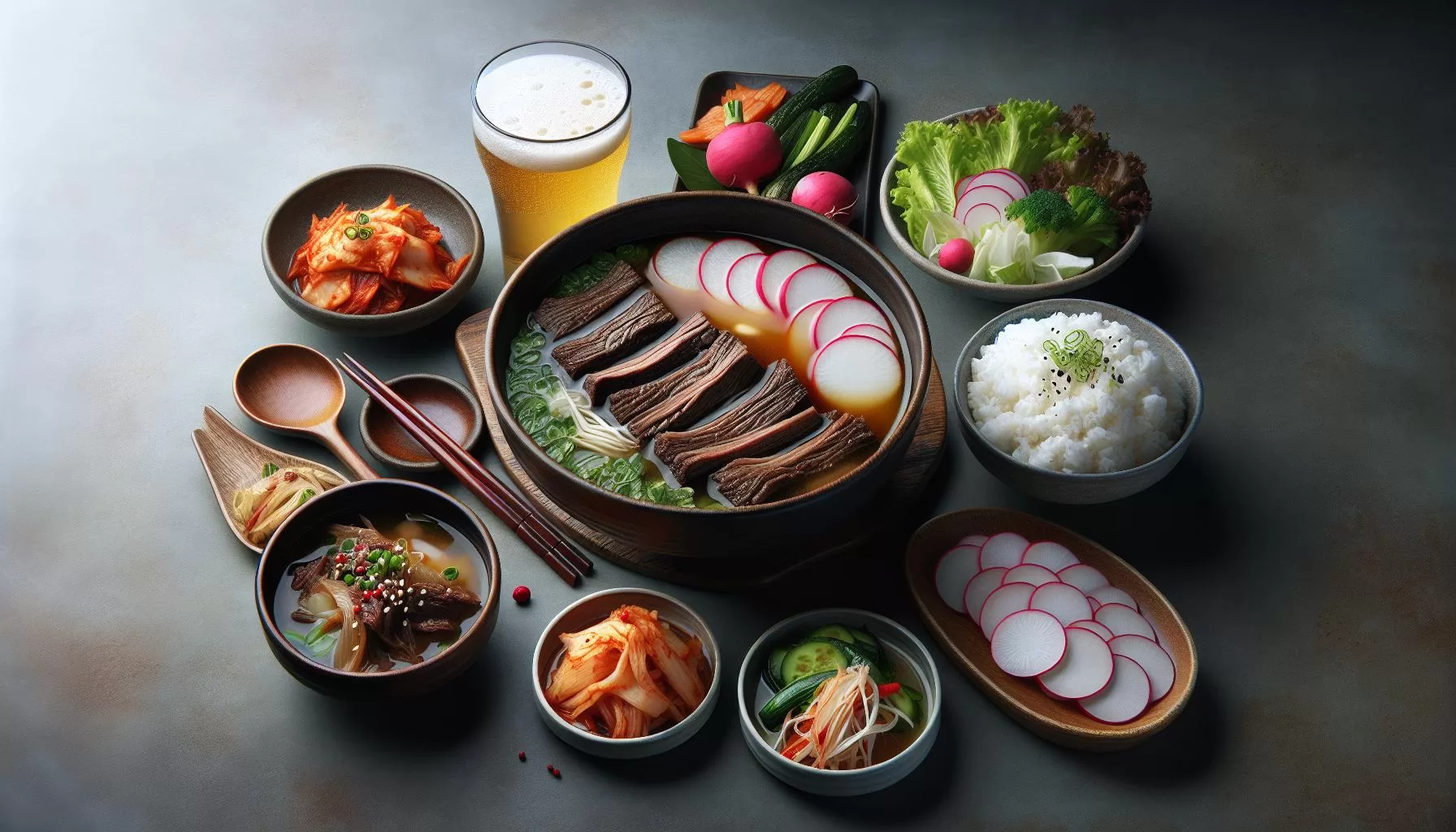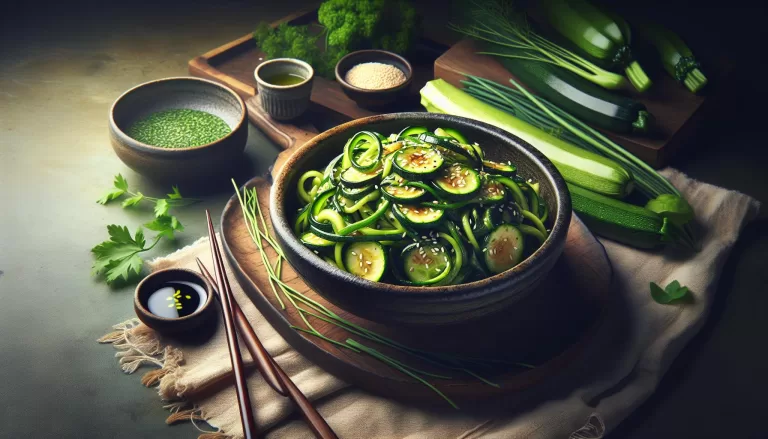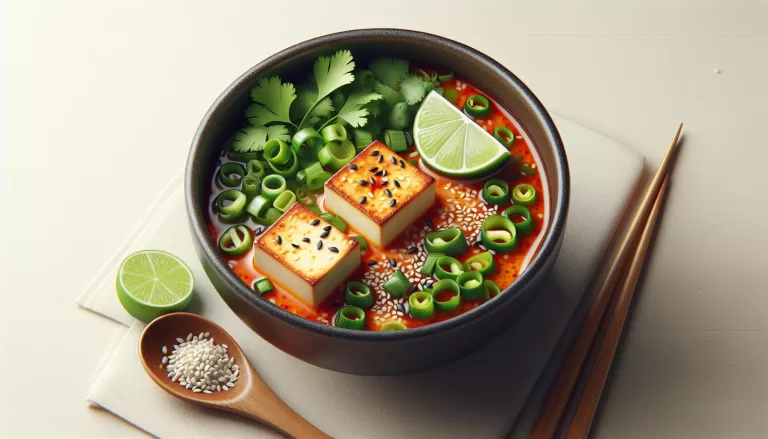Easy Homemade Galbitang Beef Short Rib Soup Recipe for Family Meals and Gatherings

Selecting the Ingredients
With a dish as robust and flavorful as galbitang, your choice of ingredients plays a critical role. Quality over quantity is the mantra here. It’s a simple list, but you should be selective to ensure the best taste.
For the star of the show – the beef short ribs – you’d want nothing less than the best quality bone-in beef short ribs you can find. The bones add a depth to the soup, elevating the flavor to a level plain meat simply can’t reach.
You need good, solid vegetables as well. Fresh Korean radish, garlic, and green onions provide the backbone for your galbitang. Freshness is key. So pick the freshest produce you can lay your hands on. They’ll make a difference not just in taste but texture too.
As for the seasonings, some salt, black pepper, and sesame oil are all that’s required. These three simple condiments highlight the flavor rather than overpower it.
For a unique twist, sub in leek for green onions. Similar in taste but leek imparts a milder, more nuanced flavor that blends seamlessly into the soup without taking center stage.
And about those nutritional facts you’re pondering on, here’s a brief breakdown:
| Ingredient | Calories | Carbs | Protein | Fat |
|---|---|---|---|---|
| Beef short ribs | 291 | 0g | 24g | 21g |
| Korean Radish | 18 | 4g | 1g | 0.1g |
| Garlic | 4 | 1g | 0.2g | 0g |
| Green Onions | 10 | 2.3g | 0.6g | 0.1g |
| Salt, Pepper, Sesame oil | varies slightly based on usage |
Remember to balance your ingredients well while cooking. It’s the harmony of these elements that’ll make your homemade galbitang truly unforgettable.
Preparing the Beef Short Ribs

Having selected your high-quality ingredients, it’s now time to prep your core element – the beef short ribs. As the centerpiece of your homemade galbitang, the manner in which you handle these ribs determine the soup’s overall success.
Begin by placing 2 pounds of bone-in beef short ribs into a large pot. You’ll want to completely submerge these ribs in cold water – about 8 cups should do the trick. This process of soaking the ribs does more than just cleanse; it draws out excess blood and impurities from the bone marrow, creating a cleaner taste in your eventual soup.
Here’s a pro-tip: let the ribs soak anywhere between 1 to 2 hours, changing the water at 30-minute intervals. But, for those in a rush, don’t fret. Releasing impurities can be sped up by blanching the ribs in boiling water, for approximately 10 minutes.
(After soaking or blanching, make sure to rinse the meat and bones under cold water.)
As you rinse, take some time to remove visible fat. While galbitang traditionally embraces a robust and rich flavor, reducing fat levels can lead to a leaner, healthier soup – taking the caloric content from approximately 300 to 275 per serving.
Let’s take a glimpse at a sample nutritional breakdown:
| Quantity (Per Serving) | |
|---|---|
| Calories | 275 |
| Carbohydrate | 5g |
| Protein | 30g |
| Fat | 20g |
| Vitamin A | 1100IU |
| Vitamin C | 3.9mg |
Remember, ensuring the quality of your ingredients and your prep-work defines your homemade galbitang experience. The process might seem laborious but the end result — a soothing, comforting bowl of beef short rib soup — will be worth every effort.
Next up – preparing the Korean radish and assembling your selections of aromatic greens! Stay tuned for the celebration of textures and flavors in our next step.
Making the Galbitang Broth

Your next adventure in cooking the homemade galbitang begins by crafting the flavorful broth. Soups like galbitang often owe their character and soul to their broths. Yours should be no exception.
You’ll want to start with the beef short ribs. You’ve already cleaned these. Remember quality is important and this has been mentioned already. Place the ribs in a large pot, cover with cold water and bring it to a gentle boil. Now, isn’t it time to let your ribs simmer? Keep the heat at low. With minimal agitation, it’ll cook gently. Ensure an even and deep extraction of the wonderful flavors locked within the bone-in ribs.
Are you worried about the fat? Don’t be. The simmering process will see most of the fat rise to the surface. You can skim off this excess with ease periodically.
A couple hours in, add in Korean radish or mu, cut into thick chunks. No Korean radish at hand? Feel free to substitute it with Daikon radish. These radishes add an interesting textural contrast and soak up the beefy flavors wonderfully.
It’s time for the inimitable aromatic greens. Let your soup meet with fine slices of green onions. Plunge in minced garlic. Ah! The soup already smells amazing. The greens inject their bright notes into the emerging symphony of flavors.
You’d agree that this galbitang journey becomes more exciting as you delve deeper. It’s important to remember, the homemade galbitang is not just a meal. It’s an experience, a culinary joy ride.
Nutritional Breakdown:
| Ingredient | Calories | Protein | Carbs | Fat |
|---|---|---|---|---|
| Beef short ribs | 342 | 35g | 0g | 23g |
| Korean radish | 18 | 0.6g | 4.1g | 0g |
| Green onions | 5 | 0.3g | 1.2g | 0g |
| Garlic | 4 | 0.2g | 1g | 0g |
Notice the stark contrast? The meat brings familiar warmth while the greens provide fresh accents. Balance is key for memorable experiences. Are you ready for more culinary experiments in the kitchen? There’s no better time to start than now.
Cooking the Beef Short Ribs in the Broth

First things first, you’re ready to cook those beef short ribs in that delicious broth you’ve prepared. Bring your broth to a gentle simmer. Remember not to rush this: high heat can make the beef tough, while low and slow simmering will ensure every bit of flavor is extracted.
Grab about 1.5 lbs of short ribs. That’s the sweet spot for this dish. You don’t want to go overboard with the meat, just enough to savor the taste and texture.
| Quantity | Ingredient |
|---|---|
| 1.5 lbs | Beef short ribs |
Let’s talk about cooking duration. You’re aiming for something like 1.5–2 hours of simmering. It might seem like a long time but, trust us: it’s worth the wait.
Consider adding some unique flavors to the mix. A small shot of aged whiskey could enhance the umami rich broth. Or try a spoonful of black bean paste for that deep, savory flavor. But, as always, the choice is yours. Shake up your soup game by injecting some personal flavor.
| Optional Additions | Quantity |
|---|---|
| Aged Whiskey | 1 shot |
| Black Bean Paste | 1 spoonful |
While this might be an unusual move, the resulting flavor depth will surprise you positively. Lastly, remember – the longer the ribs simmer the more flavorsome your soup!
We know some of you are keeping a close eye on what you eat. We’ve got your back. The nutrient content of a standard serving of this soup (assuming you opt for the black bean paste) is good news for protein lovers.
| Nutrient | Amount per serving |
|---|---|
| Calories | 553 kcal |
| Protein | 51g |
| Fat | 30g |
| Carbohydrates | 16g |
So there you have it. It doesn’t get much simpler than this. Now it’s over to you—enjoy cooking and savoring this delightful dish! Stick around for our next section where we’ll dive into serving suggestions and presentation tips for impressing your guests with your culinary creation.
Serving and Enjoying

Having the perfect beef short ribs broth simmering on the stove, filling your kitchen with that heavenly aroma, is no less than a culinary achievement! You may be wondering, “What next?” or “How do I serve this?” Don’t worry, we’ve got you sorted.
You’ve patiently prepared the broth, let the ribs bask in its warmth nicely, and then it’s time to plate this delicacy. A bonus is this dish is extremely versatile when it comes to serving. It can be a heartwarming family meal or an impressive dish for any gathering. Here are a few tips and tricks on presentation, garnishing, and complimenting dishes.
To make each serving exciting, a smart tip is to have diversity on the plate. Pair your rich, savory short ribs with a fresh, crisp side salad or stir-fried mixed veggies. The contrast of flavors gives your taste buds a balanced palette enhancer.
Presentation can be a game-changer. While serving, allocate each bowl with an ample portion of short ribs. Add slices of radish. Did you know radish is not only garnishing but also complements the beef flavor incredibly? Now tip in the broth, being careful not to splash. Gently does it!
Want to take it to another gourmet level? Add a few thin slices of raw, aged beef on top of the soup. Just before serving, pour the piping hot broth over those slices. The heat slightly cooks the beef, enhancing the flavour even more! This is one stellar presentation that’s sure going to wow your guests.
As for pairing, this delicious short rib soup goes perfectly well with steamed white rice and a side of your favorite kimchi. Remember, it’s the combination of contrasting flavours that often creates a memorable dining experience. Don’t be afraid to experiment!
While you’re at it, have a cold beer ready. It enhances the rich flavors of the beef short ribs soup, cleaning your palate, and setting you up for another burst of galbitang goodness.
Conclusion
You’ve just explored the art of making homemade galbitang beef short rib soup. It’s versatile, perfect for family meals or special gatherings. Remember, presentation and pairing are key to impressing your guests. A side salad or stir-fried veggies can add color and balance to your dish, while radish slices and raw aged beef can enhance the visual appeal. Don’t forget to serve it with steamed white rice, kimchi, and a cold beer for the ultimate Korean dining experience. Now, it’s your turn to put this recipe into practice and wow your loved ones with your culinary skills. Happy cooking!





